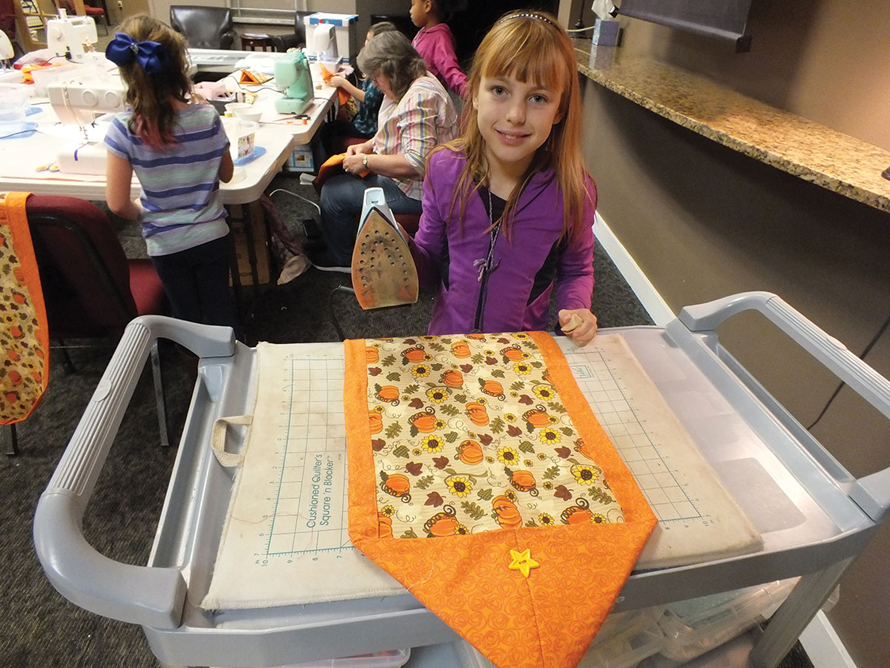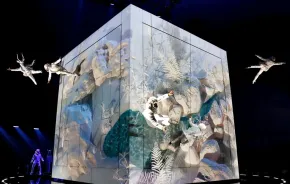
4-H club sampler
“Urban” 4-H club projects range from urban farming to dog training to STEM. Here’s a sampling of clubs in our region. Find a club and join 4-H here or here.
Seattle: Cooped Up in Seattle: urban farming; A Book of Adventure: sewing, cooking and science
Vashon Island: Eyes of the Future: training guide dogs
Des Moines: Igniting Magnificent Minds: science and technology
Snohomish: Botsmiths: robotics
Monroe: Esprit de Corps: computers, model railroads, small animals
Auburn: Master Builder Robotics: science and robotics
Woodinville: Puppy Power: training service dogs
Renton: Teen Leaders of Tomorrow: youth leadership
Redmond: Better Basics; robotics and science
On a wintry Sunday night in early January, a few dozen parents and kids from a Pierce County 4-H club fill out a cavernous church basement in Tacoma’s North Slope neighborhood. The monthly meeting of the “Amocat” (Tacoma spelled backward) club is a group potluck; parents mingle over homemade butternut squash soup and kale salad as kids scarf down the last remaining slices of pizza.
Soon, the kids — aged third grade through middle school — are conducting group business, calling a vote on a pressing matter, running through the club’s finances and issuing reminders about an upcoming snowshoeing trip to Cle Elum. Parents chat on the sidelines, ushering a few younger siblings into side room where “Cloverbuds,” or 4-Hers-in-training ages 5 through 7, work on a craft project during the meeting. (4-H is open to kids 8 to 18; Cloverbuds is a low-pressure group with fewer responsibilities than a 4-H club.)
The meeting ends with 4-H members breaking off into groups of six to eight to talk about their projects — smaller subgroups meet every couple of weeks to focus on a specific interest or hobby, in this case, sewing, rocketry and cooking. Parent (or grandparent) volunteers schedule and lead these smaller meetings.
These small groups are where the skill building in 4-H — head, heart, hands and health — takes place, and the subject matter may surprise some. Amocat’s projects range from robotics to coding to digital photography, with nary a large animal to be seen; kids can join as many projects as they’d like, for as long as they want. Amocat is what’s informally known as an “urban” 4-H club, or one without an agricultural focus.
The Amocat group isn’t an oddity: About 1.8 million of 4-H’s nearly 6 million participants live in urban communities; 1.6 million are suburbanites; and 2.6 million reside in rural areas. Now the country’s largest youth development organization, 4-H has a century-long history that is steeped in agriculture and rural farming — the first club grew tomatoes and corn in the early 1900s in Clark County, Ohio.
In 1914, the passage of the Smith-Lever Act formed the cooperative extension program through the USDA, creating a means of support for 4-H clubs nationally. Regardless of locale, 4-Hers reap some significant benefits: Tufts University’s Positive Youth Development Survey, a longitudinal study of 7,000 youths begun in 2002, found that 4-Hers are four times more likely to give back to their communities, twice as likely to be civically active, twice as likely to participate in science, technology, engineering or math (STEM) activities outside of school, and less likely to be sexually active in high school.

Finding urban 4-H
Both the family-friendly, bring-all-your-kids group meetings and the focus on child-led learning and leadership appealed to the Mingus family of Tacoma, Amocat members since the fall of 2015.
When Rebekah Mingus started scouting out extracurricular activities for her oldest daughter, Katie, now in third grade, she knew what she wanted: something without religious underpinnings, something that wouldn’t bury the family’s calendar under an avalanche of meetings, something inclusive and not gender-specific, and something that promoted enjoyment and skill mastery rather than rank. Most 4-H groups meet at least every other month with smaller, project-centered group meetings usually held a couple of times per month.
A friend told Mingus about a 4-H group composed mostly of families from Tacoma’s public Montessori community. It sounded like a good fit, and it was. “4-H seems to focus more on cooperation with other club members, and less on competition,” she says. “There’s no race to obtain a rank, badge or station.”
There’s no finish line for learning in 4-H, says Brian Brandt, 4-H faculty lead for WSU Pierce County Extension. Many similar programs give kids a taste of a potential hobby, he says, but once the kids demonstrate proficiency, they move on to something else. “With 4-H, you can keep coming back to cooking or sewing or photography to develop mastery over the years,” he says.
The focus on lifelong learning is helping Mingus’ daughter Katie conquer her sewing machine. Now on her third sewing project, she’s pieced together a complex quilt and isn’t being sidelined by bent needles or snarled thread. “I’m a lot better at threading my machine now, and at fixing my machine, too,” she says.
Dollars and sense
Through a mix of public and private funding, 4-H offers experiences that might otherwise be out of reach for many kids, like access to robotics or rocketry gear or travel to STEM conferences. Brandt and his counterparts in other county cooperative extension offices actively seek out grants to supplement USDA and state dollars.
For projects like Katie’s exploration of sewing, families pay a nominal supply fee, generally less than $20; 4-H membership is only $15 annually; and the cost is waived for families that can’t afford it. Affordability is part of 4-H’s appeal, says Mingus.
“With three kids, we can’t pay to play constantly,” she says. “With 4-H, there are no uniforms or badges to purchase, and often grants cover things like outings, cameras and laptops for the kids to use.”
At the club level, kids can choose to raise funds based on their group’s goals, but they don’t have to participate in any council-led fundraiser, says Kevin Wright, a 4-H youth development faculty member for King County. “If clubs choose to fundraise for their expenses, they aren’t expected to share funds with any upper-level organization.”

Cultivating connections
This financial flexibility has allowed 4-H groups to thrive in unique situations. Tina Reeves leads the Canine Connections 4-H group at the Echo Glen juvenile detention center in Snoqualmie; it’s an offshoot of the Puppy Power club based in Woodinville. In the program, nine live-in teen inmates, a mix of boys and girls, rehabilitate nine shelter dogs marked for euthanasia through a mix of daily training and cognitive behavioral therapy. After two months of training, the dogs are adopted through PetFinder. Thanks to public and private funding, members’ parents don’t pay any fees for participation, says Reeves.
For science- and tech-based clubs, like the Master Builder Robotics club in Auburn and the Better Basics computer club in Redmond, 4-H grants help cover supply fees for technology that might otherwise be prohibitive.
And the results are priceless: “I’ve seen the toughest-exterior kids build love and empathy with their dog,” says Reeves. “They’re learning that you can accomplish positive goals without using any force.”
4-H isn’t right for everyone, of course. Families seeking a gender-specific experience — say, mom-daughter or father-son bonding — or a structured club for kids under 8 may want to look elsewhere, since 4-H tends to mix boys and girls and ramps up after age 8.
“I’ve always encouraged parents to not just do 4-H,” says Brandt. Referring to the Tufts youth development survey results, he notes, “We know that kids who participate in 4-H along with other activities have the best outcomes.”











